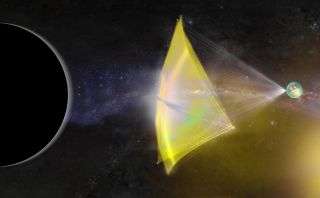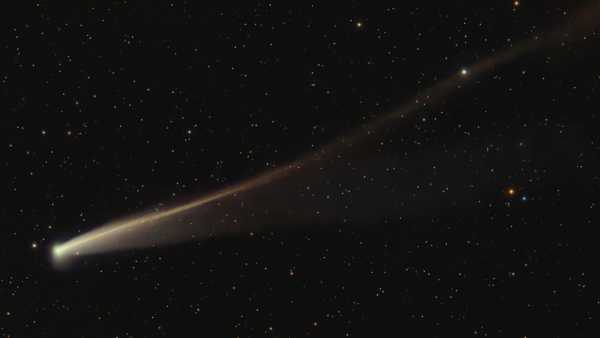
Physicist Edward Witten proposed using a fleet of laser-launched probes, like Breakthrough Starshot, to hunt the mysteries gravity source known as “Planet 9.”
There’s something heavy in the outer reaches of our solar system. At least, it seems that way. Hints of it are scattered across the farthest reaches of our sun’s neighborhood — that something 5 to 10 times the mass of Earth tugging on nearby objects with its gravity. No one’s ever seen it, as this phantom has eluded years of searches by telescopes. In fact, not everyone believes it’s real. For now, most astronomers refer to it as “Planet 9.”
Now, the famous theoretical physicist Edward Witten has published a paper on how to track down this specter haunting our outer solar system: a fleet of tiny probes, pushed via lasers to a blistering 0.1% of the speed of light. Blanket that part of space with hundreds of little probes, Witten argued in the new paper, and the fleet should be able to pin down the lost object’s location. (The paper has not yet been peer reviewed or accepted for publication in a journal.)
Witten is a theoretical physicist and mathematician at the Institute for Advanced Study in New Jersey, best known for his work on the mathematics of quantum field theory and as the progenitor of string theory’s unifying “M-theory.” He was also the first physicist to win the Fields Medal, the most prestigious prize in mathematics. None of those accomplishments are typical bullet points on the resume of a NASA mission designer, Witten readily admits.
“It is far from clear if my proposed way to search for Planet 9 is practical, or if it is the best way even if it is practical,” he told Live Science.
Witten’s idea borrows heavily from Breakthrough Starshot. Cofounded by billionaire physicist Yuri Milner, Stephen Hawking and Mark Zuckerberg, Breakthrough Starshot aims to explore the Alpha Centauri star system 4.37 light-years from Earth. The idea behind Starshot is to push a small probe to 15% or 20% of the speed of light and reach the star 20 to 30 years after launch. Announced in 2016, the project doesn’t have a firm launch date.
“In the search for Planet 9, a project along the lines of Breakthrough Starshot has two major advantages,” Witten wrote in the paper, published April 29 to the arXiv database. “Large velocities may be attainable, and it is practical to launch a very large number of spacecraft, possibly hundreds or more.”
A big fleet of small probes
Witten’s idea to track down the missing object requires each probe to carry just two devices: a very precise clock and a radio transmitter.
A probe would send a short message to Earth every time its clock ticked, letting its Earthbound owners know the time aboard the spacecraft. But as the probe got farther and farther from Earth, and the messages took longer and longer to travel, those messages would arrive with longer and longer delays. Sync those clocks up to atomic clocks on Earth, then track their delays, and you can precisely calculate the distance of each probe from Earth at any given time.
That allows researchers to create a map of how the fleet moves through space over time. The first several years should be quite predictable: The major gravity fields of the inner solar system are well understood; we can see where the most of the planets are simply by looking up. But in about a decade after launch, the probes would reach the “trans-Neptunian” region where Planet 9 could lurk.
“As the spacecraft passes by Planet 9, it is accelerated by the object’s gravity. As a result, it is at any given time farther from Earth than expected, and a signal from the spacecraft arrives on Earth a little later than it would if the object is not there,” Witten told Live Science.
By tracking which of the spacecraft are moving faster, and by how much, Witten predicted that the fleet would be able to map Planet 9’s gravity and track it down. He calculated that in order to work at 0.1 % the speed of light, the clocks would have to be accurate to 1/100,000th of a second and the fleet would need hundreds of probes.
Building the laser facility would be expensive, he noted, citing a figure of $517 million based on a Breakthrough Starshot report. But once the facility was constructed, each new probe launch would be cheap, requiring $8,000 worth of battery power plus the cost of the relatively simple probe.
Any gravity source will do
Witten’s idea has been met with a combination of excitement and deep skepticism from the astrophysics community.
Already, the search for Planet 9 has gone on long enough that some astronomers have begun to suggest there might be some feature of the object that’s keeping it hidden. Maybe it’s silhouetted against the bright band of the Milky Way. In that instance, the dim reflection of the sun from the planet’s surface would be drowned out by the bright shine of our galaxy. Or maybe it’s not a planet at all, but something more exotic.
In October 2019, a pair of physicists proposed that Planet 9 might not be a planet at all, Live Science previously reported. A grapefruit-sized black hole, which weighs about as much as a planet, might have been created in the early universe and have ended up in our outer solar system. But even the authors of that paper don’t think such a scenario is likely; even so, they’ve begun hunting for the signature of a dark matter halo that would encircle such a black hole: gamma rays, produced when dark matter “annihilates” itself.
The advantage of Witten’s proposal is that if it worked, it would work for any gravity source, said James Unwin, a University of Illinois at Chicago physicist and one of the authors of the grapefruit-sized black hole paper. Even if the object is so exotic that we can’t ever directly see it, a map of its gravity well would help astrophysicists figure out where — and, hopefully, what — it is.
“Professor Witten is considering, essentially, the nightmare scenario, which is that it’s a planet that is unobservable. Or maybe it’s hidden in a part of the sky which is really hard to see, or maybe it’s a black hole but the dark matter doesn’t annihilate [to produce gamma rays],” Unwin told Live Science, adding, “It’s like throwing a big net out there.”
Planets, black holes, and even more exotic, theoretical objects (think: “quark nugget”) could all trip the big net, Witten said.
Turbulence hits the big idea
The problem is, there’s good reason to doubt Witten’s proposal would work in real life.
Pete Worden, retired director of NASA’s Ames Research Center and chair of the Breakthrough Prize Foundation (which runs Breakthrough Starshot), told Live Science that “we are very interested in Dr. Witten’s suggestions [and] are following up with both him and the broader scientific and engineering community on this exciting suggestion.”
However, he deferred to Avi Loeb, a Harvard astrophysicist and chair of the Breakthrough Starshot Advisory committee for “detailed comment.”
Loeb, known for his own sometimes-extraordinary ideas, told Live Science that Witten’s proposal forgot a key feature of the neighborhood where Planet 9 might orbit.
Because Witten’s idea involves very fast-moving spacecraft hunting a fairly small mass, the clocks have to be very precise to be useful, Loeb said. At 0.1% of light speed, every fraction of a second represents a huge distance traveled. That’s why Witten calculated that the clocks on the probes would have to be accurate to 1/100,000th of a second. And, Loeb said, it makes the measurements susceptible to being ruined by even minor disturbances.
And that region of space has just such a disturbance waiting.
“Planet 9 resides outside the heliopause, where the solar wind is confined by the interstellar medium,” Loeb said.
Voyager 1 and Voyager 2, fast NASA probes launched in 1977, first reached the heliopause in the last decade — the only human-built probes to do so. Neither has yet reached the distances where Planet 9 is thought to orbit. Past the heliopause, the solar wind is no longer at your back. Instead, you’re buffeted by the radiation and charged dust that floats between stars — the interstellar medium.
“As soon as I read Witten’s paper, I realized that the interaction with the interstellar medium would introduce noise that far exceeds the signal he aims to retrieve,” Loeb said.
“In particular,” Loeb told Live Science, “the drag force exerted on the spacecraft by the interstellar medium could be orders of magnitude larger than the gravitational force of Planet 9, and unpredictable fluctuations in this force due to turbulence would introduce noise that would obscure the desired signal. In addition, the small charge that the spacecraft will acquire from the impact of the interstellar medium particles on its surface would cause a deflection in its trajectory by the interstellar magnetic field that is larger than the gravitational deflection caused by Planet 9.”
Loeb said that the underlying principle of Witten’s plan might work, but not in the context of Planet 9, pointing to a 2017 paper he coauthored in The Astrophysical Journal Letters. In that paper, Loeb proposed using a similar sort of measurement to measure the gravity of exoplanets as Breakthrough Starshot whizzes past Alpha Centauri.
That proposal relied on a more complex, never-before-tried method for measuring acceleration at such extreme speeds. And Alpha Centauri’s own solar wind might protect the Starshot craft from the interstellar medium, making the measurement possible in a way that he said is not possible with Planet 9.
Slowing down Witten’s proposed craft to increase its sensitivity wouldn’t be practical either, Witten said.
“A chemical rocket, moving at a slower speed, would take a century to reach Planet 9,” he said.
Loeb summarized his criticism of Witten’s paper in another paper, published to arXiv May 3.
“I have seen the paper,” Witten said. “He is raising a serious concern and may well be correct.”
Still, Loeb said, there are reasons to be excited about Witten’s line of thinking.
“Beyond Planet 9, there are many other good reasons to launch fast probes to targets within the solar system,” he said.
There are all sorts of objects in our solar system that are impractical to study using big probes launched on chemical rockets, Loeb said. Insterstellar comets like ‘Oumuamua blaze through our solar system too fast for conventional probes to catch and study in detail. And the relatively low cost would make laser-launched probes useful for studying potential life-harboring environments like the plumes of water above Saturn’s moon Enceladus.
Sourse: www.livescience.com





